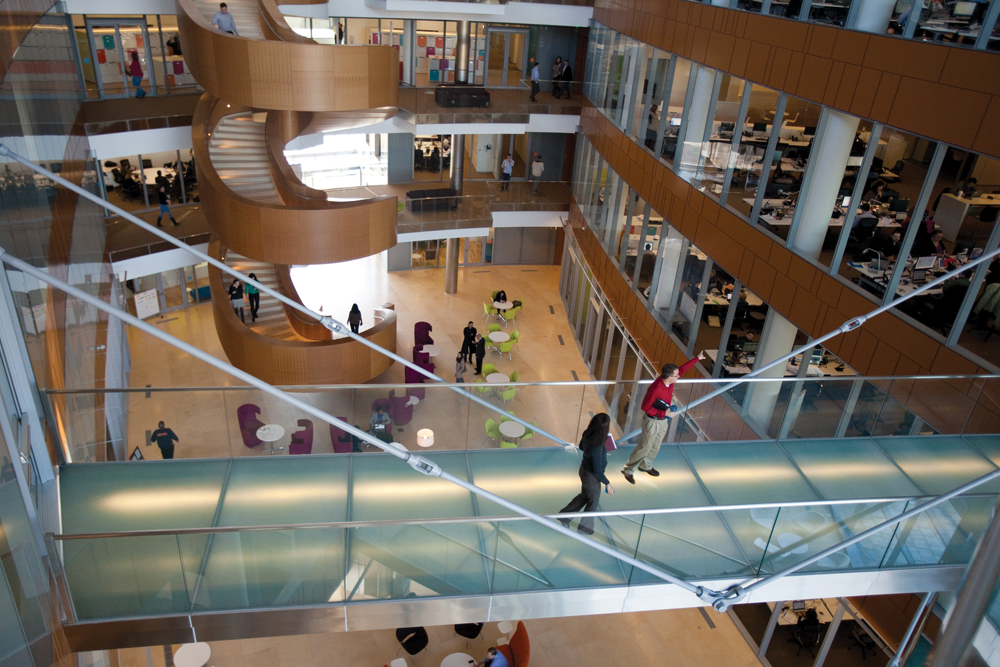Many firms that do office design and construction stayed afloat during the recession with modest projects—fit-outs, renovations, targeted green retrofits. But the sector’s finally heating up.
Commercial Realtors recently reported an increase in annual gross income for the third year in a row (www.BDCnetwork.com/Realtors2013). Jones Lang LaSalle’s latest office forecast pegged more than a dozen metros as being in “a rising phase,” including Austin, Dallas, Boston, Denver, Pittsburgh, Indianapolis, and New York (http://bit.ly/JLLOffice13).
Though speculative projects still lag, corporate HQs and medical office buildings are moving ahead. “The medical office building of the future can accommodate much of what was done in a traditional hospital setting,” says Steve Straus, President of Glumac. “Some of our clients have bold ambitions, including net-zero.”
TOP OFFICE SECTOR ARCHITECTURE FIRMS
2012 Office Revenue ($)1 Gensler $462,700,5002 HOK $128,726,0003 Perkins+Will $107,951,6724 NBBJ $64,002,0005 Stantec $62,500,2366 PageSoutherlandPage $43,190,0007 Heery International $39,443,9318 Kohn Pedersen Fox Associates $38,081,0009 RTKL Associates $37,474,00010 Hammel, Green and Abrahamson $37,307,000
TOP OFFICE SECTOR ENGINEERING FIRMS
2012 Office Revenue ($)1 AECOM Technology Corp. $830,320,0002 Parsons Brinckerhoff $146,400,0003 Jacobs Engineering Group $95,180,0004 Burns & McDonnell $82,020,0005 Thornton Tomasetti $50,861,4676 Michael Baker Jr. $50,720,0007 WSP USA $48,500,1628 Arup $32,355,6079 Buro Happold Consulting Engineers $28,720,00010 AKF Group $26,917,000
TOP OFFICE SECTOR CONSTRUCTION FIRMS
2012 Office Revenue ($)1 Turner Corporation, The $2,195,790,0002 Structure Tone $1,435,332,0003 PCL Construction Enterprises $1,409,212,7274 Clark Group $974,974,0665 Skanska USA $847,106,2426 Balfour Beatty $792,915,5767 Gilbane $690,915,0008 JE Dunn Construction $613,825,5639 James G Davis Construction $575,006,00010 HITT Contracting $535,524,009
On the West Coast, tech firms are creating eye-popping campuses, including NBBJ projects for Amazon (Seattle, 3.3 million sf); Samsung (San Jose, 1.1 million sf, with Arup); and Google (Mountain View, Calif., 1 million sf). Facebook tapped Frank Gehry to design its 420,000-sf Facebook West in Menlo Park, Calif., and Foster + Partners is designing Apple’s 2.8 million-sf, net-zero Campus 2 in Cupertino (to be built by DPR-Skanska.)
Bleeding-edge companies seek the latest in social engineering and sustainability, but they’re not alone in believing that generational and technological trends justify a reboot in office design. “The relevance of ‘the office’ is in question,” says Steve Hart, Director of Interior Design at Heery. “Why are you even in an office? We believe the office needs to help individuals feel connected to the company and support a common sense of purpose.”
Read BD+C's full Giants 300 Report
Related Stories
| Apr 5, 2011
Top 10 Buildings: Women in Architecture
Making selections of top buildings this week led to a surprising discovery about the representation of women in architecture, writes Tom Mallory, COO and co-founder, OpenBuildings.com. He discovered that finding female-created architecture, when excluding husband/wife teams, is extremely difficult and often the only work he came across was akin to interior design.
| Apr 5, 2011
What do Chengdu, Lagos, and Chicago have in common?
They’re all “world middleweight cities” that are likely to become regional megacities (10 million people) by 2025—along with Dongguan, Guangzhou, Hangzhou, Shenzhen, Tianjin, and Wuhan (China); Kinshasa (Democratic Republic of the Congo); Jakarta (Indonesia); Lahore (Pakistan); and Chennai (India), according to a new report from McKinsey Global Institute: “Urban World: Mapping the economic power of cities”.
| Mar 30, 2011
China's low-carbon future city
In 2005, the Chinese government announced its target to reduce energy consumption per GDP unit by 20% by the year 2010. After a multi-billion investment, that target has been reached. The Chinese Climate Protection Program’s goal to increase energy efficiency, develop renewable energies, and promote energy savings while reducing pollutant emissions and strengthening environmental protection is reflected in the “Future City” by SBA Design.
| Mar 30, 2011
Is the AEC industry at risk of losing its next generation leaders without better mentoring?
After two or three horrifying years for the AEC industry, we are finally seeing the makings of a turnaround. However, data developed by Kermit Baker as part of the AIA Work-on-the-Boards survey program indicates that between 17% and 22% of design firms are eliminating positions for interns and staff with less than six years of experience. This data suggests the industry is at risk of losing a large segment of its next generation of leaders if something isn't done to improve mentoring across the profession.
| Mar 29, 2011
City's design, transit system can ease gas costs
Some cities in the U.S. are better positioned to deal with rising gas prices than others because of their design and transit systems, according to CEOs for Cities, a Chicago-based nonprofit that works to build stronger cities. The key factor: whether residents have to drive everywhere, or have other options.
| Mar 29, 2011
Chicago’s Willis Tower to become a vertical solar farm
Chicago’s iconic Willis Tower (formerly the Sears Tower) is set to become a massive solar electric plant with the installation of a pilot solar electric glass project.
| Mar 29, 2011
Read up on Amazon.com's new green HQ
Phase IV of Amazon’s new headquarters in Seattle is nearly complete. The company has built 10 of the 11 buildings planned for its new campus in the South Lake Union neighborhood, and is on-track for a 2013 grand opening.
| Mar 29, 2011
Portuguese architect Eduardo Souto de Moura wins Pritzker Architecture Prize
Portugese architect Eduardo Souto de Moura, whose precisely-honed buildings reflect the influence of the late Chicago modernist Mies van der Rohe, is the 2011 winner of the Pritzker Architecture Prize, the field's highest honor.
| Mar 25, 2011
Qatar World Cup may feature carbon-fiber ‘clouds’
Engineers at Qatar University’s Department of Mechanical and Industrial Engineering are busy developing what they believe could act as artificial “clouds,” man-made saucer-type structures suspended over a given soccer stadium, working to shield tens of thousands of spectators from suffocating summer temperatures that regularly top 115 degrees Fahrenheit.












